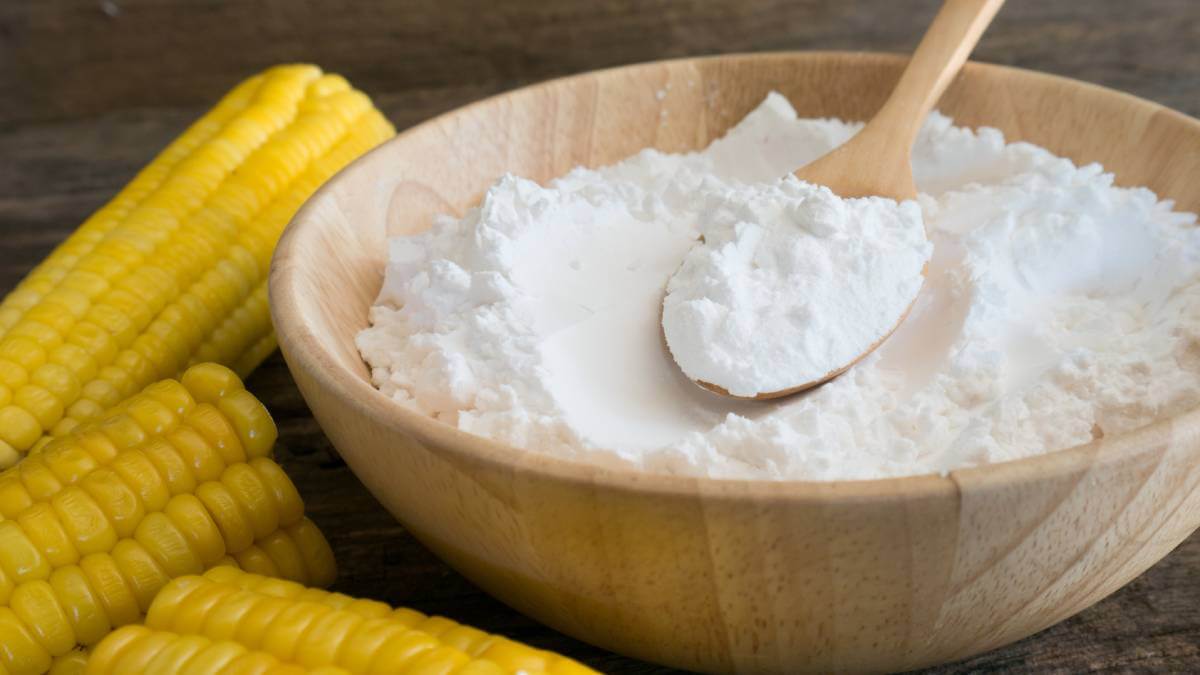Cornflour is one of those products that is always sold in a large box, but you only tend to use it every now and again. A tablespoon here to thicken up a stew, a teaspoon there to coat meat for a stir-fry. But this handy starch has a multitude of uses beyond the kitchen. It’s often used to make paper, adhesives and coatings, and researchers are testing its properties in pest control methods.
We already know cornflour is good for cooking, so what else can it do?
What is cornflour?
Cornflour, also known as maize starch or cornstarch in the US, is the starch derived from corn grain. The starch is obtained from the endosperm of the kernel. It’s a common food ingredient, often used to thicken sauces or soups, and to make corn syrup and other sugars.
Ease sunburn
As much as we try to avoid sunburn, sometimes it does happen. Before rushing out to buy some aloe vera gel, though, check the kitchen cupboard. A light paste made with water and cornflour can be dabbed on sunburnt skin to take away some of the pain and redness.
A light dusting of corn starch can reduce painful friction between your body and any material next to it. Sprinkle it on your skin wherever there is irritation from clothing to prevent chafing or spread it over bedsheets for a silky sleep that’s friction-free.
Use as an egg substitute
Do you ever just get the urge to bake something only to open the fridge and find you forgot to buy eggs? Luckily, a mix of cornflour and water can replace an egg in many baked items. The ratio varies between recipes but typically one tablespoon of cornflour and three tablespoons of water matches the liquid content of one egg. Ensure you dissolve the cornflour well in cold water to avoid lumps. This is also useful if you need to whip up some vegan baked goods!
Take the sting out of bug bites
It’s that time of year again when we can spend the evening relaxing on the deck. If the bug sprays, citronella candles and mosquito coils don’t quite work and you find yourself with a bite, mix up a thick paste of cornflour and water and apply it to the bite. You can even leave it on overnight to work its magic.
Detangle dog fur
Many dogs get matted fur and, along with looking scruffy, it can be painful for them. If you want to avoid cutting out the tangles, try rubbing a generous amount of cornflour into the area and work it into the fur. Then use a slicker brush to loosen the tangle and comb it through with a wide-tooth grooming comb.
Use as a dry shampoo
Cornflour is excellent at soaking up oil, which makes it a great dry shampoo substitute. Mix two parts cornflour with one-part baking soda, sprinkle close to your roots and brush through thoroughly. The solution will absorb grease and make your hair look and feel fresher. It also adds volume and can make hair look thicker.
Combat blisters
Keep feet smooth and dry with a sprinkle of cornflour before slipping on shoes without socks. If you get a blister despite these efforts, cornflour can help with that too.
Blisters and sores often secrete small amounts of fluid, which can attract bacteria and lead to infection. Apply a small amount of cornflour to the wound to keep it clean and dry. Do not use a thick ointment, such as petroleum jelly, as this will keep it from drying and healing.
Use as a household cleaner
Cornflour has many uses as a cleaner. To shine up silver, rub on a thick water-and-cornflour paste, let it dry and then buff with a soft cloth. It’s great at removing furniture polish build-up on wood, just sprinkle it on and add some elbow grease.
A popular glass cleaner is known as ‘Alvin Corn’ and is made up of 1/4 cup rubbing alcohol, 1/4 cup white vinegar, one tablespoon cornflour and two cups of warm water. Mix it up in a spray bottle and use on windows for a streak-free shine.
Make a deodorant
Cornflour’s ability to absorb moisture, along with its lack of scent, makes it an excellent ingredient for an all-natural deodorant. Mix equal amounts of cornflour and baking soda in the palm of your hand and apply with an oversized makeup brush or cotton balls. This is a great swap for people having radiation treatment for cancer, as regular deodorant can irritate treated skin.
Have some fun with the grandkids
Cornflour and water make a great, fun slime. Mix one cup of water with two cups of cornflour, press into a slippery ball with your hands and watch it transform back to a liquid when you let go. Add food colouring or glitter for some extra sparkle.
Wash up with plain warm water, but to avoid a clog, throw the slime in the bin, never down the drain.
Make fluffy eggs
We have to head back to the kitchen for this last one. You can make your morning omelettes extra fluffy with the help of cornflour. Add 1/4 teaspoon of cornflour per egg, then beat well before cooking your omelette.
Tips for keeping cornflour fresh
- Cornflour absorbs moisture so keep it in an airtight container protected from humidity.
- Keep cornflour away from any heat sources
- Always store it in a cool, dry place.
Do you use cornflour around the house? What is your favourite multi-purpose kitchen ingredient?
Also read: How to take your burgers to the next level

